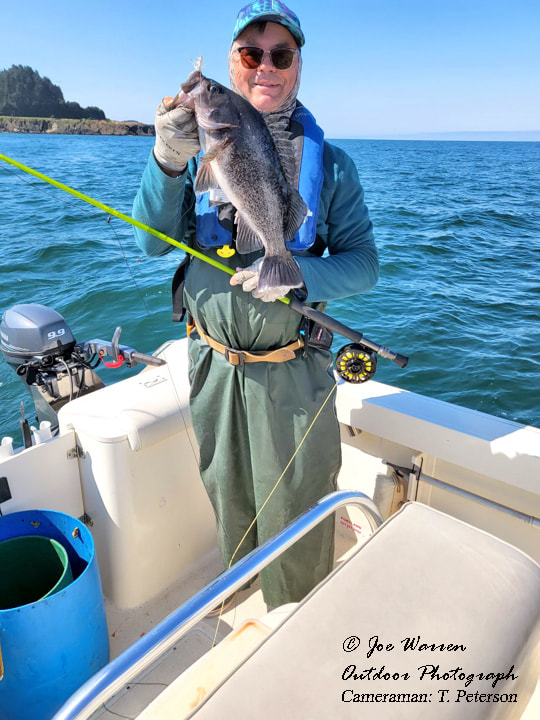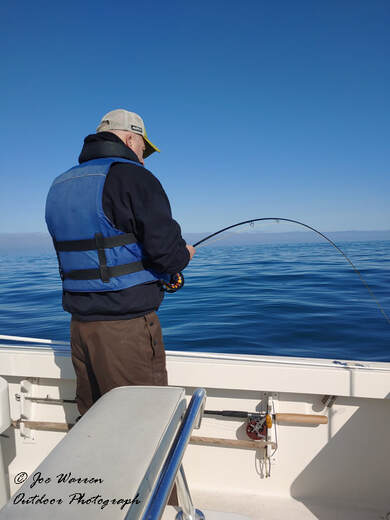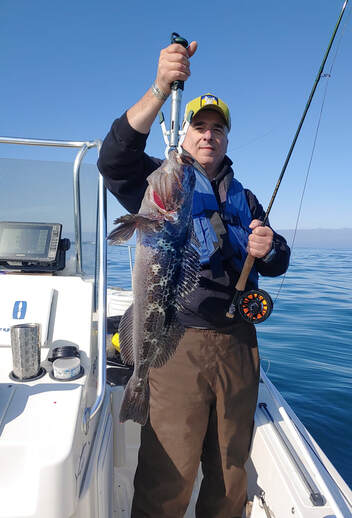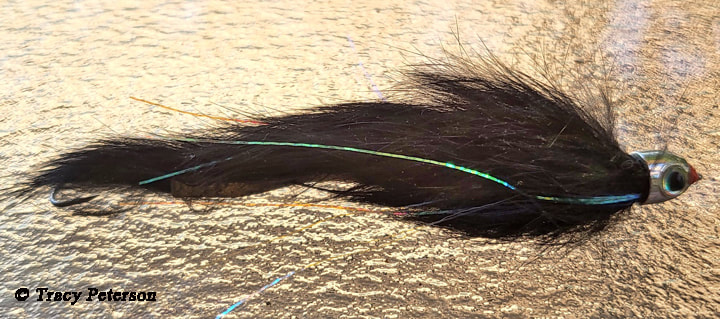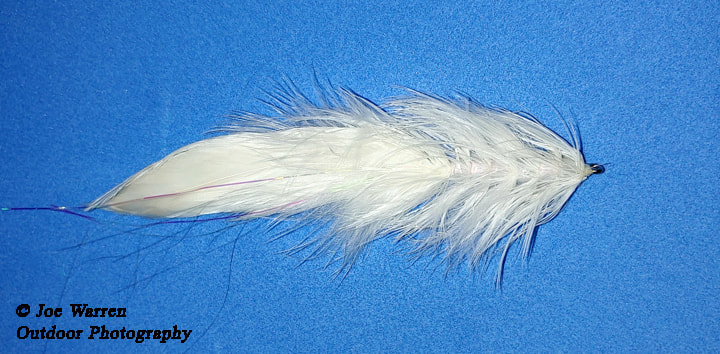Depoe Bay Fly Fishing The author with a very nice black rockfish, while fly fishing outside Depoe Bay, OR, from his boat. It's always a crap shoot on what the ocean is going to bring you in the way of weather. As I began to monitor the marine conditions, I finally see an open window and hope it will be close to accurate! I anxiously ring up Tracy Peterson from Hareline to tell him, "now is the time"! This is the first trip of the season to take the Josie Mae over to Depoe Bay and start the season, only this time with the fly rods! I've waited a long time for this and having fly fished many times in other locations on the coast, I would finally fly fish in my own boat! Nature has a way of telling you that you that a good day is before you. As we cleared the Depoe Bay rocky gateway, a young grey whale gently porpoised off the starboard side only a few boat lengths away. Very gracefully as if to say, "you're gonna have a great day boys!" First thing in order is dropping off the crab pots. With fresh shad for bait that was caught only a week prior (see shad fly fishing post), we scatter four pots at various depths. Now it's time to find the sea bass and whatever else lurks from the reefs! I've been fishing out of Depoe Bay since about 2000, rarely missing a season whether it was for rockfish, salmon, halibut or tuna fishing. Most of these trips were with my father, Jim. But one fateful day, he didn't come back from the ocean. In September of 2017 his boat capsized and he and his fishin buddy did not make it. I was fortunate to have fished with him only 3 days before the accident. I learned many tactics and techniques from my dad and have been blessed to continue catching! I didn't miss a lick on going back to Depoe after my father passed away. I bought my own boat the next year and kept fishing ever since. The first few years I continued taking out guys who regular fished with my dad and we recalled the good o'l days, fishin with Jim! It was also with my dad on his boat out of Charleston, OR, many years ago, that I caught my first black rockfish and lingcod while fly fishing. He and my uncle couldn't believe how fast I out fished them! Frankly, I was rather surprised myself. Fly fishing can be very deadly! There are basically two options for fly fishing the Oregon/Washington coast. From a jetty or from a boat. I've done my fair share fly fishing off of jetties and it's not for me. Kudos to those of you who are good at it, but quite frankly, I find it a hazard. The boat fly fishing is my game. The key to fly fishing from a boat off the Oregon coast is knowing the reefs and shoreline paying close attention to the depth. Fishing with gear first is a good way to learn locations. Next is picking a day or days when the marine conditions are calm enough to cast and fish with a fly rod. If the drift is too fast, forget it! Yes, you can strip out fly line without casting, and let the drift take it down to the fish as long as the sea bass are in a big area, otherwise you might lose out on drifting past them before the fly has a chance to reach them. I always take two rods, one with a 400-490 gr sink head connected to an int. sink line such as the Airflo Depth Finder and Sniper and the other rod with a floater or int. sink line just in case the fish are on top! Other comparable sinking fly lines are the Teeny T-series, Cortland Compact and the Orvis Depth Charge. I like to use an 8-wt fly rod, in glass of course, but rod weight really depends on how heavy your fly line is. My rod can easily cast 300-490 gr, so this gives me a lot of leeway on making sure I can reach the fish. Leaders should be stout! I highly recommend at least 20 lb. tippet, 4-6 ft long. I made the mistake of starting out with 15 lb and hooked into something very large, likely a ling or cabie, and before I could get the boat moving, it broke me off. Wire might not be bad idea either if you're in ling or cabezon territory. Another trick we used to make sure our flies sank quickly was adding a 1/8 oz tungest sliding bullet on the leader. No doubt this makes for some serious, "chuck n duck" casting. Bring a hard hat :) Also you can use the Popvic's Jiggy Head, a tungsten cone on the fly or again let it slide on the leader. Flies don't have to be fancy, good types are oversized buggers (use rabbit or schlappen for the tail), Clouser minnows, basic streamers that imitate an anchovy or sea lance, rabbit strung flies, like or close to a Dolly Lama, on size 1/0 to 4/0 hooks. White or pink flies seem to draw a lot of strikes and are usually my first pick for a pattern. A fair amount of flash on the fly is always good too! Be sure to throw in a few poppers (pink n white or blue n white) just in case the blacks are on top! Bunny hair patterns are great for the ocean like this Dolly Lama type fly tied by Tracy Peterson, which is what helped him catch his big lingcod! Joe's, Baja Bugger tied with large pearl glass beads, well proven from Baja to Oregon! Good electronics is your best friend when hunting for fish and saves time! The weather can change instantly, so the sooner you get on fish, the better! The primary candidate is the black rockfish or sea bass, which are found in many locations and depths. A suspended school is what you hope for. For example, if you're in 40 feet of water, hopefully the rock fish are in the first 15 feet of the water column. If you allow your fly to sink close to the bottom, you stand an excellent chance of hooking up to lings, cabezon, greenlings and other species of rock fish. Earlier I mentioned fishing next to rock shorelines, which, can attract many fish especially if there is kelp and sometimes never get touched by anglers. But beware of ocean conditions and make sure you have two motors! Keep a respectable distance, getting slammed against the rocks is a high risk! Last but not least, is the harvest! All of these fish are delicious and I love sea bass tacos! There are no size limits on the blacks but you can be selective, I would toss back any bass under 15-16 inches. 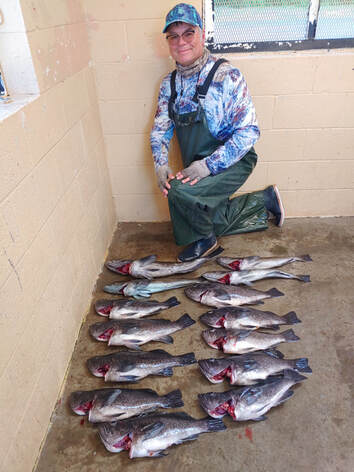 And in case you are wondering what that green fly rod is that I am holding in the top image, it is a custom built fiberglass 8 weight on a Gary Loomis Northfork blank built by George Krum. It rocks! Good fishing in your fly fish pursuits! Joe
1 Comment
Scott Pimley
7/28/2023 05:51:26 pm
Nice fish! Wish I was with you!!
Reply
Leave a Reply. |
